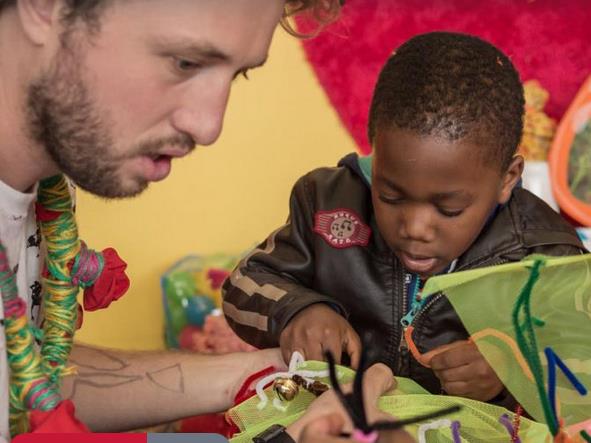Carclew Youth Arts, a small-to-medium pioneering loan schemes to finance arts
Some in the philanthropic community are beginning to take a more strategic approach to change and investment; working in partnership with each other and with government agencies to deliver better outcomes for artists and communities. But they too need to know they can continue to work with the sector and with governments and that the goal posts won’t keep changing.
Examples of such projects include:
• A new capacity-building stream from the Myer Foundation, at this stage a pilot program for organisations in Victoria or Tasmania which will be assessed partly on the recipient’s capacity to increase in connectivity, one of key characteristics of resilience.
• The inaugural IMPACT Partnership program from investment and trustee group Perpetual. This has just been announced and will distribute $6.2million to eight not-for-profit organisations including one arts organisation Big hART with over $700,000 for a five-year capacity-building program to commercialise productions.
• The partnership between the Tim Fairfax Family Foundation and the Queensland Government to create the Arts Business Innovation Fund (ABIF).
Many philanthropists are viewing with interest moves by Foundations in the US to use all their assets towards their mission; using grants and loans for capacity-building and becoming actively engaged in impact investing, including rating companies for such factors as their social and environmental impact.
Which leads to the issue of impact investing and where this fits in the future schema of arts funding. Coupled with the issue of strengthening organisations through building non-restricted income streams is the introduction of debt and equity financing into the funding equation for the arts, using the growth of impact investing to increase, not replace the sources organisations and individuals have at their disposal. Impact investing can best be described as: Investments made into companies, organisations or specialised funds with the intention to generate social, environmental and cultural impacts alongside a financial return.
There are many different models, structures and players in this emerging field but for non-profit organisations the most common products have been focused on debt financing because of the prohibition on distribution of profits. The inclusion of ‘financing’ as well as funding for ‘non-profits’ has been accepted in the US and UK for more than a decade. Here I’m going to focus on examples from the UK, which make a useful comparison with Australia because public expectation and understanding of the role of government in funding the arts has been similar to ours.
Live Theatre in Newcastle is one leading performing arts organisation focusing on new writing that has used loan financing on top of government grants and philanthropy. It has built an asset base including a pub and commercial offices as well as a range of enterprises generating income from its creative work. A recent report for Arts Council England and the Theatre Development Trust has recommended that ACE also explore the use of loans and return on investment schemes as a suite of measures to support the development of touring in the UK.
Creative England is an offshoot of the Arts Council of England and was established as an independent Community Interest Company (CIC) to carry on the work of Creative Industry Finance. It also manages Own Art and Take it Away, loan finance for purchasers of art which have been used as models for the development of Collect Art in Tasmania and Art Money in Sydney. Creative England’s purpose is to provide a range of financial products and services designed to enable the growth and development of the UK’s cultural and creative industries. It is creating a network of lenders including some interested in social enterprise, some micro finance and some larger lenders and exploring their own fund for arts organisations based on a ‘convertible loan’ structure where the loan could be repaid or converted to equity in the company.
Then there is the recently launched Arts Impact Fund (AIF) which has been in development for the last couple of years following moves by an independent group of arts professionals to create new sources of funding and finance. It is a £7 million investment fund that will provide unsecured loan finance to arts organisations (and museums) that demonstrate excellence in their artistic practice and social impact. The AIF has been created with the help of the UK Cabinet Office, which is exploring new opportunities for the co-mingling of funds, and involves a group of investors: Bank of America Merrill Lynch, Esmée Fairbairn Foundation and Nesta supported by ACE with additional funding from the Calouste Gulbenkian Foundation. The fund is being seen as a demonstration project to show how the co-mingling of funds from different agencies can work: how ‘social finance’ or impact investing can be used in the context of the arts and how to report the specific outcomes required. The AIF opened in April 2015 for unsecured loans ranging from £150,000 to £600,000. Those who apply will have to show why they need the money and explain the social impact that the investment will make in any of three contexts: youth and educational attainment; community and citizens; and health and wellbeing. They will of course also have to demonstrate how they will repay the loan. Successful applicants will be announced every six months over a two-year period and their performance and impact measurements will be published.
An outstanding example of impact investing in Australia has of course, been by one of our major performing arts organisations: the Australian Chamber Orchestra’s Instrument Fund, an unlisted Australian unit trust enabling investors to purchase fine stringed instruments for use by the musicians.
But what has been most interesting is that it has principally been organisations in the small-to-medium sector and independent artists that are having to pioneer the use of loans for business and property development through social enterprise development and investment funds (SEDIF) managed through three community finance providers, Foresters Community Finance, Social Ventures Australia and Social Enterprise Finance Australia. Individual artists are also accessing micro loans for everything from short term cashflow management to investment in marketing and professional development.
QuickstART, now managed on our behalf by Foresters Community Finance, has delivered a mix of no-interest and interest-bearing loans valued at over $150,000 to 44 artists in the last two years. The model has now been copied for two new loan schemes in South Australia, one led by Carclew Youth Arts and the other by Guildhouse.
Yet it is the larger organisations that are the more likely to have the capacity to explore these new avenues of support. I was amazed to be told by one senior arts administrator that ideas for new models are okay for the small-to-medium sector but not for the larger organisations! There is a contradiction here. Of course most of the larger organisations are under less pressure to adapt because of their strong connections to government and the business and philanthropic community. Why go looking for an affordable loan for your new building when it is likely the Government will fund it for you anyway?
Although short-lived, the Investment Advisory Board for the arts in Queensland recognised that new approaches were needed to assist the sector including partnerships to bring new money to the table. The creation of the Arts Business Innovation Fund (ABIF), where half a million dollars in government grant funds has been matched with half a million from the Tim Fairfax Family Foundation. It offers organisations up to $100,000 in matching funding through a mix of a grant and a loan. It is a requirement of the scheme that these funds be specifically directed towards new business development initiatives and to grow future sources of income for companies.
The introduction of a small loan component is unique in two ways. Firstly it has come from the corpus of the Fairfax Foundation and therefore does not impact on the grants that the Foundation will also distribute. Secondly it will give arts organisations their first experience of managing a loan as part of their broader financial model in a context which will strengthen their overall long-term financial position.
This article is an extract from Paying the Piper: There has to be a better way by Cathy Hunt, a Platform Paper published by and available from Currency House.





